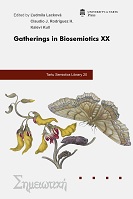Neurosemiotics: Blurbing a field beyond the “two cultures divide”
Neurosemiotics: Blurbing a field beyond the “two cultures divide”
Author(s): Adolfo M. García, Daniel Franco-O’Byrne, Agustín IbáñezSubject(s): Semiotics / Semiology, Psycholinguistics, Neuropsychology
Published by: Tartu Ülikooli Kirjastus
Keywords: semiotics; neurosemiotics; neural processes;
Summary/Abstract: One of the defining characteristics of the human species is our incessant drive to construe meaning (Deacon 1997; Halliday 1978; Ibáñez, García 2018; Peirce 1998; Leeuwen 2005). Perhaps inevitably, this ubiquitous trait has been a hotspot of research across diverse scholarly traditions. The classical study of semiotics adopted a humanistic approach, first focusing solely on the properties of signs (e.g., reference, symbolism, indication, metaphor, analogy) and eventually embracing a wider outlook on interpersonal communication that was sensitive to social dynamics and cultural niches. On the other hand, more recent trends have favored scientific, biologically-grounded perspectives, such as those of biosemiotics (Emmeche et al. 2000; Hoffmeyer 2015; Kosoy, Kosoy 2018; Sharov 2016; Sharov et al. 2016; Hateren 2015), behavioral science (Carey 2009; Mareschal et al. 2010; Murphy 2004), neuropsychology (Faust 2012; Shallice 1988), and social cognitive and affective neuroscience (Falk, Scholz 2018; Fiske, Taylor 2013; Pezzulo et al. 2019). Nevertheless, interdisciplinary pursuits in these traditions have been unsuccessful in establishing synergies among the neurological, sensorimotor, cognitive, perceptual, visceral, and interactive processes that jointly shape our semiotic experiences (Brier 2015; Ibáñez, García 2018).
Journal: Tartu Semiotics Library
- Issue Year: 2020
- Issue No: 20
- Page Range: 92-97
- Page Count: 6
- Language: English
- Content File-PDF

